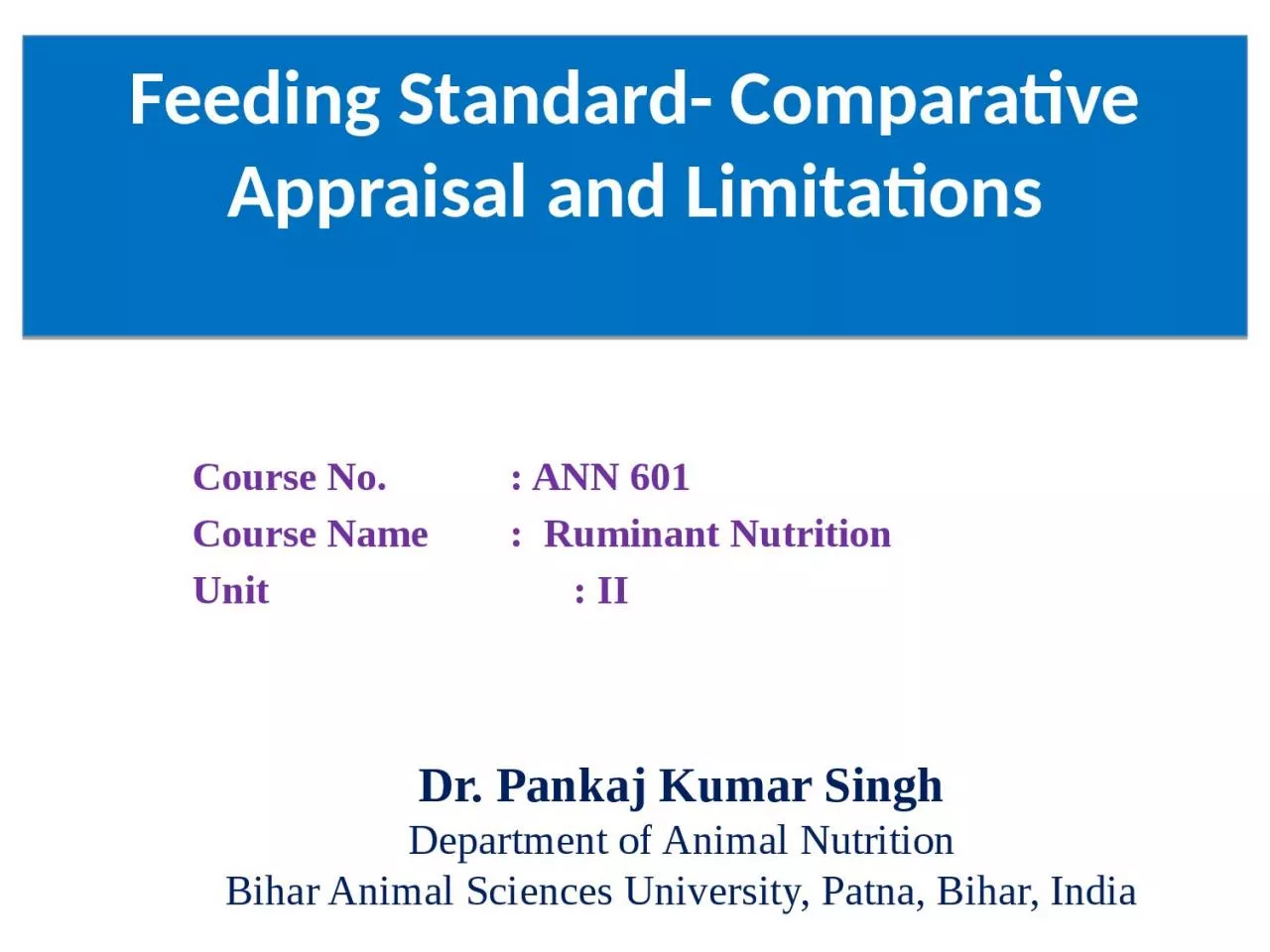

Dr Pankaj Kumar Singh Department of Animal Nutrition Bihar Animal Sciences University Patna Bihar India Course No ANN 601 Course Name Ruminant Nutrition Unit ID: 1026278
Download Presentation The PPT/PDF document "Feeding Standard- Comparative Appraisal ..." is the property of its rightful owner. Permission is granted to download and print the materials on this web site for personal, non-commercial use only, and to display it on your personal computer provided you do not modify the materials and that you retain all copyright notices contained in the materials. By downloading content from our website, you accept the terms of this agreement.
1. Feeding Standard- Comparative Appraisal and LimitationsDr. Pankaj Kumar SinghDepartment of Animal NutritionBihar Animal Sciences University, Patna, Bihar, IndiaCourse No. : ANN 601Course Name : Ruminant NutritionUnit : II
2. Usefulness of feeding standardsFeeding standard consists of the quantity of nutrients required by an animal to remain healthy and highly productiveFeeding standards are set in accordance with productivity (milk, meat, wool, eggs), composition of the product (fat content of milk), and physiological condition (growth, fetal development). Consideration is also given to varying regional conditions in feeding standard.Feeding standards serves as guides in feeding animals and in estimating the adequacy of feed intake and of feed supplies for groups of animal.Feeding standards allow effective and profitable nutritional management of animals appropriate to the prevailing nutritional, economic and sociological environment.
3. Limitation of feeding standards Feeding standard is not a complete guide to feeding as other factors such as palatability and the physical nature of the ration are not taken into account. Feeding standards are only approximately correct. The amounts of nutrients recommended in the table of feeding standards are intended to be sufficient to meet the food requirements of maximum production. Environment may change nutrient requirements. Feeding standard does not consider economics of livestock production. Feeding standards based on assigned nutritive values (e.g., net energy) are misleading when unconventional feed resources are used. Feeding standards are not permanent, but are reexamined with change in technology and production targets.
4. Merits and demerits of various feeding standardsTDN and DE systemsMerits TDN is a measure of apparent DE but is expressed in units of weight or % rather than energy per SE. TDN value provides a relative measure of the DE content of feed; 1 kg TDN = 4.409 Mcal DE. It is easy to determine the TDN content of feedstuffs; proximate composition of feeds and faeces and digestion trial are to be done. Digestible energy can readily be determined by using a bomb calorimeter to measure the GE of feed and faeces. No chemical analyses are required.
5. TDN and DE systemsDemerits TDN system takes into account only the losses of nutrients in the faeces but not the other losses from the body. TDN system over evaluates the energy value of poor quality roughages in relation to concentrates specially so in hot environment because TDN does not consider large amounts of energy wasted in the digestion of fibrous feeds in the form of gases and heat increment and Ether extract of forages largely comprise other than true fat. So a kg of TDN in roughage has less value for productive purpose than a kg of TDN in concentrate. Certain species of forage were found to have high gross energy and high TDN values due to essential oils but low ME values. The measurement of DE takes into account the losses only through faeces.
6. SE and ME systems Merits of ME systemME represents a more accurate measure since losses in urinary and gaseous products of digestion are also accounted for.ME provides a more satisfactory measure of nutritive value than do TDN or DE.ME is cheaper and easier to obtain than NE values.The efficiency of utilization of ME takes into consideration the purpose for which it is fed, level of feeding and caloric density of the diet.
7. 7.5 References: Agricultural and Food Research Council (AFRC) 1992 Technical Committee on Responses to Nutrients, report no. 5. Nutrient Requirements of Ruminant Animals: Energy, Farnham Royal, Commonwealth Agricultural Bureaux. BIS (2007). Indian Standard: Poultry Feeds- Specification, IS-1374. Bureau of Indian Standards, 9, Bahadur Sah Zafar Marg, Manak Bhawan, New Delhi, India.Bondi A (1987). Animal Nutrition. Wiley Inter Science. Cramptan EW and Harris LE. (1969). Applied Animal Nutrition. WH Freeman. French, M. H. (2015). The Development of Feeding Standards for Cattle. The East African Agricultural Journal 179-187.Garnsworthy P C and Wiseman J (1990). Recent Advances in Animal Nutrition, Nottingham, Nottingham University Press, pp. 255–75. ICAR. (2013). Nutrient Requirements of Poultry. Nutrient Requirements of Animals. Indian Council of Agricultural Research, New Delhi, IndiaMaynard, L. A., Loosli, J.K., Hintz, H. F. and Warner, R. G. (1979). Animal Nutrition. 7th Edition, McGraw-Hill, New York.Mc Donald P., Edwards R.A., Greenhalgh, J.F.D., Morgan, C.A., Sinclair, L.A and Wikinson, R.G (2010). Animal nutrition. 7th edn. Prentice Hall, Harlow, UKMorrison, FB. (1917). The Modified Wolff-Lehmann Feeding Standards. Journal of Animal Science, 1: 64–69.Ponds WG, Church DC, Pond KR and Schoknecht PA. (2005). Basic Animal Nutrition and Feeding. Wiley Dreamtech India. Thomas C 2004 Feed into Milk: A New Applied Feeding System for Dairy Cows, Nottingham, Nottingham University Press. Wu, G. (2018). Principles of Animal Nutrition. CRC Press. Taylor & Francis Group, NW
8. THANKS